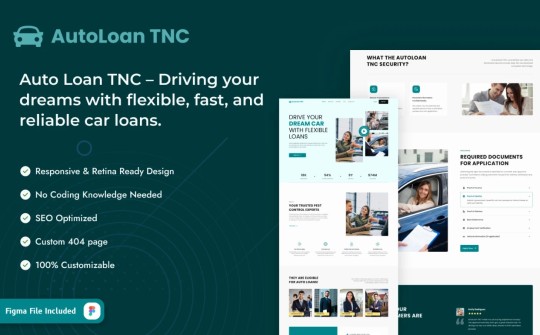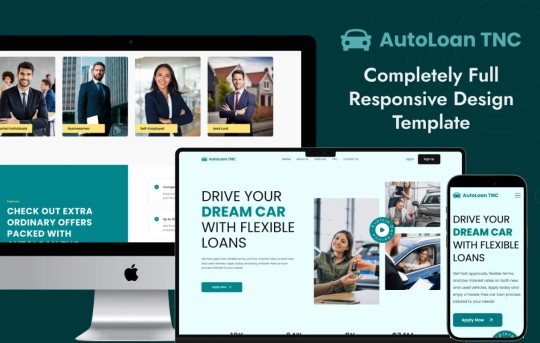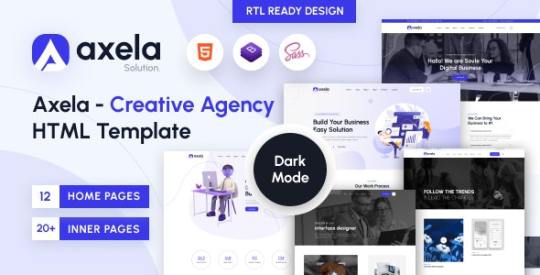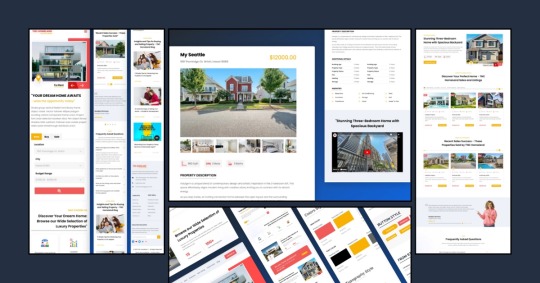#agency HTML template
Explore tagged Tumblr posts
Text
Busicol – A Powerful Free Business Website Template Built with Bootstrap 4
Why You Need the Busicol Business Template In today’s digital-first world, having a professional online presence is a non-negotiable for any business. But for startups, small businesses, or agencies just getting off the ground, the cost of web development can be a major hurdle. That’s where Busicol enters the story. It’s not just a free template—it’s a lifeline for businesses that need a modern,…
#agency HTML template#Architecture Business Template#Bootstrap 4 Admin Template#Bootstrap 4 HTML5 UI Kit Template#Bootstrap 5 template for startups#Bootstrap Business Website Template#Business Template Bootstrap#Call to action button#Carousel#Clean#Contact form#corporate design#corporate website template#CSS3 animation#Dropdown#Free Bootstrap 4 HTML5 Template#free business template#Free Responsive Agency Template#free template#Fun Fact Counters#Google Maps#Hero Header#Multipage#multipage business template#On hover effect#responsive business template#responsive startup website template#Slider#small business website template#Sticky Navigation Bar
0 notes
Text

Multipurpose HTML Landing Page Template
#multipurpose html template#multipurpose#agency html template#landing page template#css#html#bootstrap templates#agency landing page template#learn to code#frontenddevelopment
1 note
·
View note
Text
Rasti - Digital Agency HTML Template
Are you ready to take your online presence to new heights? Introducing Rasti, the comprehensive HTML template designed to elevate your digital agency's website. Crafted with the latest Bootstrap 6 technology and featuring a stunning array of color variations, Rasti is the ultimate solution for a captivating and professional online experience.
Read More - https://www.templatemonster.com/website-templates/rasti-digital-agency-html-template-432858.html
0 notes
Text
youtube
#html#css#website template#business consulting template#agency template#web developers#web designer#masukmiaeng#affiliate marketer#wordpress#business#Youtube
0 notes
Photo

New Post has been published on https://themesnulled.us/baosh-digital-agency-html-template/
Baosh - Digital Agency HTML Template
0 notes
Text
Oxentech is a powerful and flexible IT agency or Service company HTML5 template build on Bootstrap 5. This template can be used for building websites for any digital or design agency. Oxentech is a full package containing 15 fully responsive HTML templates and very useful for building website for any IT company
#digital agency#web development#agency digital marketing#branding#consulting#logo design#seo services#html template
0 notes
Text
Innovatio – Digital Marketing Agency in Trivandrum
Specialized in Google My Business Promotion

Looking to boost your local visibility? Innovatio is a leading digital marketing agency in Trivandrum that helps businesses grow through powerful Google My Business (GMB) promotion. Whether you're a small shop, a local service provider, or a growing brand, Innovatio ensures your business shows up where it matters most — on Google Maps and Search.
Core Services Include: GMB Optimization & Ranking Local SEO Website Development Social Media Marketing Google Ads (PPC) Online Reputation Management Content Creation & Branding
With a dedicated team and deep local market insight, Innovatio tailors every strategy to your business needs — helping you attract more customers, rank higher, and grow faster.
Ready to level up your digital presence? DM us or contact Innovatio today.
2 notes
·
View notes
Text
AutoLoan TNC: The Sleek Webflow Template Built for Modern Auto Finance Brands
The AutoLoan TNC Webflow template is designed to give your brand the credibility, clarity, and conversion power it needs — all without writing a single line of code.

That Drive Conversion
The AutoLoan TNC Webflow template doesn’t just look modern — it’s built with usability and scalability in mind. Let’s take a closer look at what makes it powerful:
Smart Page Architecture
Clear UX Flow — Designed with user-centric paths for lead generation Conversion-Ready Layouts — Optimized for quote forms, CTAs, and trust signals Multi-Page Structure — Includes homepage, services, about, FAQs, blog, and contact
Fully Customizable with Webflow
No-Code Editing — Change colors, content, and layout directly in Webflow Component-Based — Easily clone sections like testimonials, pricing, or FAQs CMS-Enabled — Add new blog posts or loan packages without touching the design
Responsive Across Devices
Mobile-Optimized — Looks pixel-perfect on smartphones and tablets Tablet & Desktop Ready — Seamless performance across all screen sizes Fast Load Times — Lightweight design built for speed

Clean, Modern Design Aesthetic
Professional Auto Theme — Combines clean typography with sleek UI elements Trust-Building Visuals — Showcases credibility through imagery and iconography Engaging Interactions — Micro-animations and hover effects for a polished feel
SEO & Accessibility Best Practices
Semantic HTML Structure — Optimized for search engines Alt Text & ARIA Labels — Ready for accessibility compliance Meta Tags Configured — Launch with on-page SEO baked in
Pre-Built for Business Growth
Contact & Quote Forms — Integrated with call-to-action flows Team & Testimonial Sections — Build trust and humanize your brand Blog Setup — Educate visitors with finance tips and updates

Ready to Launch Your Auto Loan Website?
If you’re ready to accelerate your digital presence with AutoLoan TNC, get the template on Webflow now and build a high-performing auto loan site that your audience can trust.
Final Thoughts
AutoLoan TNC is a game-changer for auto finance businesses. Whether you’re building in-house or working with a design agency, this template will save you time, money, and headaches — while helping you win the trust of your customers online.
#webflow#webflowtemplates#websitetemplate#template#web design#ui ux design#webflowdesign#web development#degital marketing#autoloans
1 note
·
View note
Text
In retrospective, the shift whose culmination we see today seems to be about making hardware more uniform and the system infrastructure less opaque to anyone who isn't a developer.
Looking back as a millennial, I feel like the Gen-X are the most literate computer-wise because they dealt with all the weird pre-Windows systems and physical LAN party setups before the Internet at homes became fast enough to hold online gaming. Still, it's strange to read posts like this as a Millennial who was taught to use a PC in primary school because it was a new thing for the entire generation, and then I had to pass this knowledge on to teach my own parents to send an email and not to panic whenever "my window disappeared".
What I see in my boomer parents is a sort of a mental blockade from engaging with a typical window-based UI, like every time you could literally read something on the menu and click accordingly to perform an unknown activity, my mum has a little meltdown and wants to be taught the activity step by step so she can perform it by muscle memory. The greatest peril of my mum's boomer PC experience is that she doesn't watch what's going on on her screen outside the application in focus, she is not used to interactivity on a basic level, a robust system UI is too much for her because you need to learn to "dwell" in a structure of a certain complexity, you need to get used to the thought that a PC has a massive hidden side among all the nested folders, settings and policies. I think my dad has less problems with using a PC because he had vocational technical education before, he understands mechanical schematics and electrical installation charts and abstract structures of that sort. A classic menu is a little like this.
As a kid, I was taught basics of the structure of a pre-XP Windows system. I was taught a common technique to type using as many fingers as possible, without looking at the keyboard as you do it. I was taught how to use the Office suite, how to build a simple website using the ugliest incarnation of HTML, and how to push it to the teacher's host using a FTP manager. I was even taught basics of programming in one of the code-free visual gamified editors made solely for teaching purposes. All of it to familiarize us with a certain innate logic of software that was norm at the time.
Even as an IT worker nowadays, accessing most things I need on mobile devices as a QA tester is locked behind a hidden procedure of enabling Developer tools, and even then, if you look at the folder structure on the device when accessing it from your PC, the said structure is more code-like and obviously not meant for any end user. Or, I need to use workarounds through third party applications like iTunes to even access some stuff in the first place. iOS is a true nightmare when it comes to trying access the things Apple does not want an average end user to access.
What mostly changed since my childhood is that hardware is becoming uniform to the point building your own PC and setting it up to work is easy and foolproof, and Windows is trying to be quicker in providing some template behaviors and more "transparent" in its inner workings. The mobile device design simplified user experience to the levels of "Go to store, download app, tap and swipe, the system takes care of everything else". At the same time, the systems are more intrusive, and they heavily discourage messing around and finding out. Everything is meant to be done from the status bar, or a popup that appears right at your main screen.
Teaching my parents smartphones was a different experience insofar as notifications and popups from Android keep appearing without their consent, so to speak. They feel like they have no agency over their own phone, all they want is to make a call, the entire device with its apps and ads and intrusive messages is the enemy, and "they don't want IT" (where "IT" is an SMS from the provider, a system update notification, a push notification, information about used data, there's too many icons again, there's too much everything, yada yada). Once they learned the basics of using a laptop to click things on an Internet browser, phones started to be the opposite thing.
So this was originally a response to this post:
****

****
Which is about people wanting an AO3 app, but then it became large and way off topic, so here you go.
Nobody under the age of 20 knows how to use a computer or the internet. At all. They only know how to use apps. Their whole lives are in their phones or *maybe* a tablet/iPad if they're an artist. This is becoming a huge concern.
I'm a private tutor for middle- and high-school students, and since 2020 my business has been 100% virtual. Either the student's on a tablet, which comes with its own series of problems for screen-sharing and file access, or they're on mom's or dad's computer, and they have zero understanding of it.
They also don't know what the internet is, or even the absolute basics of how it works. You might not think that's an important thing to know, but stick with me.
Last week I accepted a new student. The first session is always about the tech -- I tell them this in advance, that they'll have to set up a few things, but once we're set up, we'll be good to go. They all say the same thing -- it won't be a problem because they're so "online" that they get technology easily.
I never laugh in their faces, but it's always a close thing. Because they are expecting an app. They are not expecting to be shown how little they actually know about tech.
I must say up front: this story is not an outlier. This is *every* student during their first session with me. Every single one. I go through this with each of them because most of them learn more, and more solidly, via discussion and discovery rather than direct instruction.
Once she logged in, I asked her to click on the icon for screen-sharing. I described the icon, then started with "Okay, move your mouse to the bottom right corner of the screen." She did the thing that those of us who are old enough to remember the beginnings of widespread home computers remember - picked up the mouse and moved it and then put it down. I explained she had to pull the mouse along the surface, and then click on the icon. She found this cumbersome. I asked if she was on a laptop or desktop computer. She didn't know what I meant. I asked if the computer screen was connected to the keyboard as one piece of machinery that you can open and close, or if there was a monitor - like a TV - and the keyboard was connected to another machine either by cord or by Bluetooth. Once we figured it out was a laptop, I asked her if she could use the touchpad, because it's similar (though not equivalent) to a phone screen in terms of touching clicking and dragging.
Once we got her using the touchpad, we tried screen-sharing again. We got it working, to an extent, but she was having trouble with... lots of things. I asked if she could email me a download or a photo of her homework instead, and we could both have a copy, and talk through it rather than put it on the screen, and we'd worry about learning more tech another day. She said she tried, but her email blocked her from sending anything to me.
This is because the only email address she has is for school, and she never uses email for any other purpose. I asked if her mom or dad could email it to me. They weren't home.
(Re: school email that blocks any emails not whitelisted by the school: that's great for kids as are all parental controls for young ones, but 16-year-olds really should be getting used to using an email that belongs to them, not an institution.)
I asked if the homework was on a paper handout, or in a book, or on the computer. She said it was on the computer. Great! I asked her where it was saved. She didn't know. I asked her to search for the name of the file. She said she already did that and now it was on her screen. Then, she said to me: "You can just search for it yourself - it's Chapter 5, page 11."
This is because homework is on the school's website, in her math class's homework section, which is where she searched. For her, that was "searching the internet."
Her concepts of "on my computer" "on the internet" or "on my school's website" are all the same thing. If something is displayed on the monitor, it's "on the internet" and "on my phone/tablet/computer" and "on the school's website."
She doesn't understand "upload" or "download," because she does her homework on the school's website and hits a "submit" button when she's done. I asked her how she shares photos and stuff with friends; she said she posts to Snapchat or TikTok, or she AirDrops. (She said she sometimes uses Insta, though she said Insta is more "for old people"). So in her world, there's a button for "post" or "share," and that's how you put things on "the internet".
She doesn't know how it works. None of it. And she doesn't know how to use it, either.
Also, none of them can type. Not a one. They don't want to learn how, because "everything is on my phone."
And you know, maybe that's where we're headed. Maybe one day, everything will be on "my phone" and computers as we know them will be a thing of the past. But for the time being, they're not. Students need to learn how to use computers. They need to learn how to type. No one is telling them this, because people think teenagers are "digital natives." And to an extent, they are, but the definition of that has changed radically in the last 20-30 years. Today it means "everything is on my phone."
50K notes
·
View notes
Text
Will AI Replace Frontend Developers? Myths vs. Reality

With tools like ChatGPT, GitHub Copilot, and website builders becoming more advanced, it’s natural to wonder if artificial intelligence will eventually take over frontend development completely. Many businesses, students, and even tech professionals are asking this question.
Let’s break down what’s real and what’s just hype.
What AI Can Currently Do in Frontend Development
AI tools today can write HTML, CSS, and even simple JavaScript code. Platforms like Wix, Framer, or Webflow already allow non-coders to build websites using visual editors powered by AI. GitHub Copilot, for example, can autocomplete lines of code based on context.
These tools are great for tasks like:
Creating static website layouts
Suggesting code snippets
Fixing minor bugs
Writing repetitive functions
However, these tasks represent only a small part of what a frontend developer does. The real work goes far beyond just writing code.
Why Frontend Developers Still Matter
Frontend development isn’t just about typing out HTML and CSS. It includes thinking through user experience, performance, accessibility, responsive design, and aligning visuals with a brand's goals.
Developers also work with designers, SEO teams, and backend developers to make sure everything functions smoothly. This requires human judgment, collaboration, and real-world understanding — things AI still can’t match fully.
Understanding the Limits of AI
AI works based on patterns in existing data. It’s great at repeating what it has seen before, but it struggles with:
Making creative design decisions
Handling unexpected edge cases in user behavior
Solving problems in real-time collaboration
Understanding the purpose or business logic behind a feature
Even a simple requirement like adjusting layout behavior on different screen sizes for specific user flows often needs real testing, logic, and human touch.
Also, AI-generated code may look clean, but it can contain security flaws or performance issues that aren’t immediately obvious.
Will AI Replace Junior Developers First?
AI might impact tasks often assigned to junior developers. Writing standard form components, implementing simple layouts, or building starter templates may be automated to an extent.
But even junior developers add value through testing, debugging, and learning how to adapt solutions to real project needs. Instead of replacing them, AI can be a learning tool — helping new developers build confidence and save time.
The Role of Frontend Developers Will Change
Instead of full replacement, it’s more accurate to say the role of frontend developers is changing. They’ll increasingly work with AI, using it to speed up the routine parts of the job.
In the same way calculators didn’t replace mathematicians, AI won’t replace developers — but it will change the way they work. Adaptability and willingness to learn new tools will be essential.
What It Means for Businesses
For business owners and startups, AI in web development may lower entry costs for basic websites. But for anything custom, scalable, or built around specific goals, skilled developers are still essential.
Many businesses still rely on real experts — whether it's a software firm or a digital marketing agency Bhubaneswar — to create websites that load fast, rank well, and reflect their identity. A basic AI-built site won’t offer those deeper advantages.
In fact, some companies are already partnering with a digital marketing agency in Bhubaneswar to integrate AI tools into their workflows while maintaining the human oversight needed to produce quality, reliable outcomes.
Final Thoughts
AI is changing how websites are built, but it’s not replacing frontend developers — at least not the good ones. It’s a tool, not a substitute. Developers who embrace AI will likely be more efficient and valuable, not less.
So if you're learning frontend or running a business, don’t fear AI. Use it wisely, and you’ll get ahead instead of falling behind.
#digital marketing agency bhubaneswar#digital marketing agency india#performance marketing agency#performance marketing agency odisha#performance marketing agency bhubaneswar#online reputation management companies in india
0 notes
Text
Chimper – Stunning Free Bootstrap Business Template to Elevate Your Online Presence
Why Every Growing Business Needs a Stunning Online Template The digital presence of a business can make or break its brand credibility. In today’s hyper-competitive market, where first impressions are made within seconds, a well-designed website becomes a necessity, not a luxury. This article explores Chimper – Free HTML5 Bootstrap 4 Business Website Template, created to solve a common challenge…
#agency HTML template#Animation#Architecture Business Template#Art Studio Bootstrap template#Bootstrap 4 Agency Template#Bootstrap 4 Business Template#business website template#Carousel#Chimper template#Clean#developer-friendly HTML5#Dropdown#Email Subscription#free HTML5 website theme#free website theme#Hero Header#Multipage#responsive business template#responsive design#startup website#startup website HTML template#Video Player
0 notes
Text

Multipurpose HTML Template
#multipurpose html template#agency html template#business html template#html css#css#responsive template#bootstrap templates#agency template#webdesign#html#css3#frontenddevelopment
1 note
·
View note
Text
Creating a Custom WordPress Theme: Is It Worth It?
What Is a Custom WordPress Theme?
A custom WordPress theme is a website suit tailored from scratch. It doesn’t come off the rack. It’s built to fit a brand perfectly. Every pixel has a purpose. Every line of code whispers intention. No generic sliders, no bloated plugins, just sleek and personal design engineered to impress.
Unlike off-the-shelf themes, custom ones are designed with you in mind. Your colours. Your fonts. Your layout. Your goals.
Why People Usually Avoid It
—Mostly because it sounds intimidating. You need to know HTML. You need CSS, maybe even PHP. For beginners, that’s a foreign language cocktail. It also costs more. A pre-made theme might set you back $50. A custom one can demand $5,000 or more. For some, that’s a dealbreaker.
There’s also time. Custom themes aren’t made in a day. They take weeks or months. Clients want things fast. This puts pressure on designers and developers alike.
The Shine of a Custom Theme
Despite the hurdles, custom themes glow. They offer unmatched control.
Want a portfolio grid with animated transitions? Done.
Need a layout that shifts with seasons or promotions? Easy.
Custom themes bend to your vision.
Speed is another win. Pre-made themes often come overloaded. They include features you’ll never use. That adds weight, slowing down load time. Google frowns on that. Users click away. Rankings drop. However, custom themes are lean. They load fast. They perform better.
Security? Another big one. Custom themes avoid the vulnerabilities found in bloated or abandoned themes. Hackers often exploit common flaws. A unique theme is like a secret bunker. No obvious doors.
The Branding Bonus
Pre-made themes scream “template.” They look good but not special. If a dozen websites use the same layout, yours fades into the crowd.
Custom themes carve out identity. They speak your brand’s language. They reflect values. They also show care, thought, and strategy.
Think of Apple. Would they ever use a basic theme? Never. Their site breathes design. That design strengthens trust and confidence. Yours can too.
The Developer’s Playground
For web developers, custom themes are playgrounds. They’re creative sanctuaries. Places to experiment, innovate, and test skills.
A custom build isn’t just work—it’s expression. Developers love the challenge. Designers find joy in shaping something original. Every block, every button, it’s their artwork.
Drawbacks to Weigh
Custom themes bring headaches. If the developer vanishes, who fixes bugs? If you need an update, who rewrites the code?
Maintenance becomes essential. Someone has to patch security holes and ensure plugin compatibility. This adds long-term effort.
There’s also the learning curve. If you manage the site yourself, you need to understand the backend. Not knowing how to use custom features can make you feel locked out of your own house.
Who Should Get a Custom Theme?
Not everyone needs one, let’s be honest. If you’re running a blog for your dog, a free theme works. If you’re launching a portfolio site for a weekend project, templates are fine. But if you’re a business? A brand with vision? An artist with style? Then, yes. A custom theme elevates your presence.
It’s for serious people with goals and ambition.
E-commerce sites benefit big time. Custom checkout flows can boost conversions. Product pages can be sculpted to highlight features. The entire funnel can be optimised for user behaviour.
Agencies also gain from it. A custom site shows expertise and commitment. When a client lands on it, they feel something. They sense the difference. That can be the tipping point.
Is It Worth the Money?
Let’s break it down.
A pre-made theme might cost less today. But what about tomorrow? You may spend hours customising it, fighting with settings, and struggling with updates. Eventually, you might hire someone to fix it or rebuild it.
That adds up.
A custom theme, while expensive up front, might save money in the long run. It’s built to your needs. You won’t need to force it to fit. No awkward workarounds.
More importantly, think about reputation. A clunky site reflects poorly. A sleek, fast, tailored website shows professionalism. Clients notice that, and it can bring more business.
Customisation vs. Overcomplication
Be careful, though. Some custom builds go overboard. They add too much and make it hard to manage. So, remember that clean code is key. Simple interfaces matter.
Smart custom themes focus on usability. They consider future edits. They make updates easy. Good developers think ahead. They build themes that grow with you, not against you.
If your developer disappears, you should still feel confident. That’s the sign of a great custom theme.
Conclusion:
So, is it worth it?
Yes—if you care about your brand, a custom WordPress web design pays off.
No—if you’re on a tight budget, your site has basic needs, or you’re just testing ideas. Then, a pre-made theme will do the job.
But for those who aim high? Who wants something crafted, not copied? The answer is clear. A custom WordPress theme isn’t just worth it. It’s essential.
It’s not just design. It’s a statement.
If you agree and would like to explore further, contact Make My Website today.
0 notes
Photo

New Post has been published on https://themesnulled.us/axela-creative-agency-portfolio-html-template/
Axela - Creative Agency & Portfolio HTML Template
0 notes
Text
Insurai – Insurance Company HTML Template + RTL

Build a modern, powerful insurance website with Insurai – Insurance Company HTML Template + RTL! Packed with 9 homepages, 38+ inner pages, and powered by Bootstrap 5, this responsive template is perfect for automotive, health, family, travel, and all types of insurance sectors.
With Elementor support, one-click demo import, RTL readiness, and lifetime updates, customization is a breeze. Whether you're launching for an agency, agent, or financial firm—Insurai ensures sleek design and flawless performance across all devices. Touch-friendly, SEO-optimized, and cross-browser compatible.
0 notes
Text
Elevate Your Real Estate Presence with TNC Homeland Webflow Template
In a digital-first market, your real estate website should work as hard as you do. TNC Homeland on Webflow delivers a sleek, conversion-optimized platform for real estate professionals who want to turn clicks into closings.

Who Is TNC Homeland Built For?
🚀 Real Estate Agencies & Brokers : Build a premium online presence to attract more clients.
✨ Individual Agents & Teams : Stand out with a personalized, professional website.
🎯 Property Developers & Investors : Present projects with high-impact visuals and structured portfolios.
🌴 Vacation Rental Managers : Create engaging experiences with listings, maps, and booking features.
Key Features of TNC Homeland Webflow Template
✅ Responsive Design — Perfectly adjusts to any screen size.
✅ Dynamic CMS Collections — Manage listings, blog posts, and testimonials effortlessly.
✅ Custom Hero Sections — Grab attention with sliders, video headers, and striking calls-to-action.
✅ Advanced Property Search — Search and filter by price, location, type, and more.
✅ Google Maps Integration — Help users find properties with interactive maps and custom pins.
✅ Lead Capture Tools — Integrated forms, popups, and CTAs boost conversion.
✅ SEO-Friendly Build — Clean HTML, schema markup, and structured content for better rankings.
✅ Smooth Animations — Delight visitors with scroll effects and responsive interactions.
✅ Built-In Blog — Share insights, tips, and news to drive traffic and establish authority.
✅ Robust Documentation & Support — Get step-by-step help whenever you need it.
Why Choose TNC Homeland on Webflow?
No-Code Design: Update content visually without needing a developer.
Fast & Reliable Hosting: Enjoy fast load times with Webflow’s global CDN.
Scalable Layouts: Grow your portfolio and add pages easily.
Secure by Default: SSL encryption, backups, and trusted hosting.
Intuitive Editor: Empower non-tech teams to edit live content.
Pro Tips for Real Estate Success with TNC Homeland
Use Tags & Categories: Organize listings by features, price ranges, or neighborhoods.
Optimize Image Sizes: Ensure fast page loads with WebP formats.
Add Social Proof: Use testimonials to build trust and convert leads.
Keep the Blog Fresh: Improve SEO and engagement with regular content.
Test Your CTAs: Refine buttons and placements to improve click-through rates.

Final Thoughts: Make Every Listing Count
TNC Homeland is more than a template — it’s your digital partner in real estate growth. Built on Webflow, it combines style, speed, and scalability, helping you turn property browsing into meaningful action. Whether you’re a solo agent or scaling a property business, this template helps you put your best listings forward and keep leads coming back.
🔗 Explore TNC Homeland Webflow Template Check out the full demo, detailed features, and pricing at TNC Homeland Webflow Template by TNCFlow.
#webflow#webflowtemplates#websitetemplate#template#web design#ui ux design#webflowdesign#businesswebsite#web development#real estate
1 note
·
View note